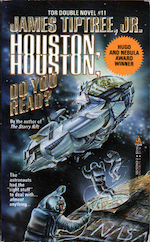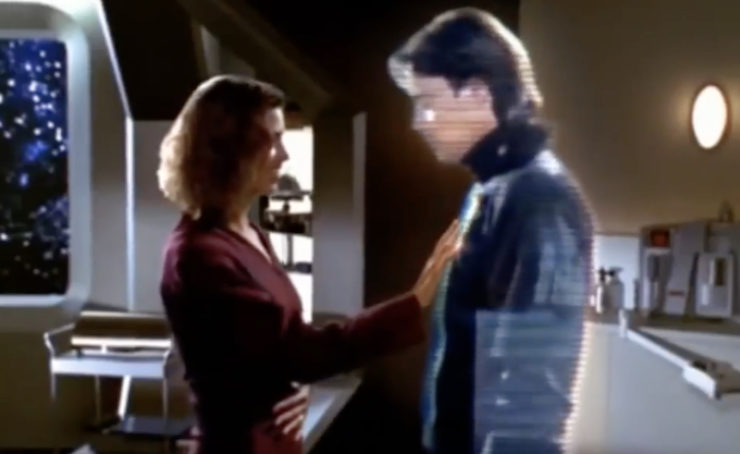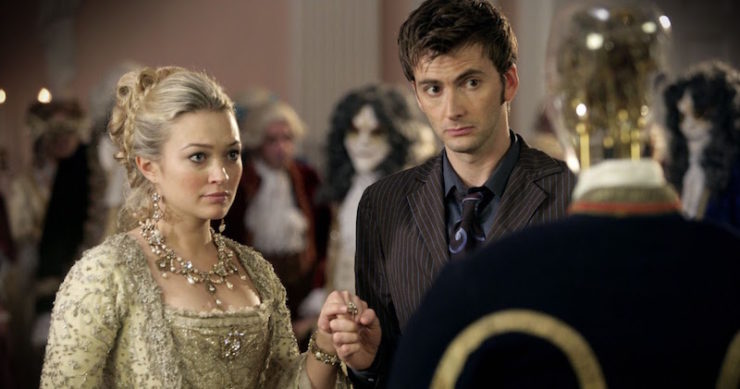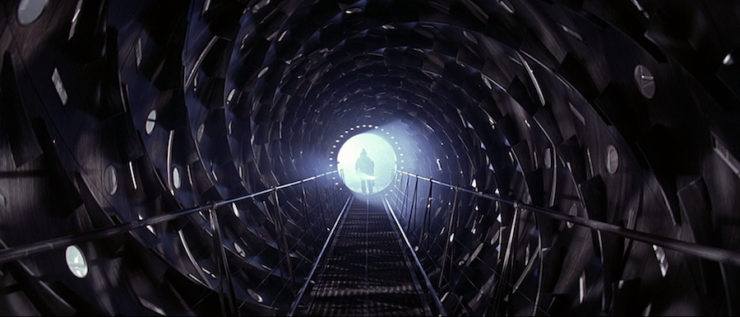For millennia lost ships—or, even spookier, ghost ships—have captured the imaginations of seafarers and landlubbers alike. It was inevitable, then, that tales of derelict ships would gain a new kind of resonance in science fiction, where ships can be the size of entire planets, and yet still vanish entirely within the black.
The set-piece of a lost spaceship is fertile ground for storytelling; an opportunity to tell stories that range from the humorous to the philosophical, from the intimate to the epic. Here are five examples of what we mean.
1. They let the reader imagine themselves as adventurous risk-takers chasing big opportunities.
 The Martian Queen, the Titanic of the stars, is the height of luxury. From its expansive ballrooms to crystal chandeliers depicting the ship’s path back and forth between Earth and Mars, it is so vicariously exorbitant that it automatically makes you cooler just by engaging with it. And that’s exactly why Saga and Michel take the job to hack the abandoned space liner in Andrew Neil Gray and J.S. Herbison’s The Ghost Line.
The Martian Queen, the Titanic of the stars, is the height of luxury. From its expansive ballrooms to crystal chandeliers depicting the ship’s path back and forth between Earth and Mars, it is so vicariously exorbitant that it automatically makes you cooler just by engaging with it. And that’s exactly why Saga and Michel take the job to hack the abandoned space liner in Andrew Neil Gray and J.S. Herbison’s The Ghost Line.
What’s ironic is that this couple’s reasons for taking on “one last job” before a much-needed break from the business are not at all glamorous: They need the money to buy medicine for Saga’s mother, plus thaw out a frozen embryo or two so they can finally start a family.
Even if Saga is thinking ahead to more sensible uses for their payment, she ensures that her customers get the full vicarious thrill of exploring the Martian Queen: Her interactive narratives layer stories over the raw footage, so that whoever plugs into the interactive gets to pretend like they’re either a member of the hoi polloi jetting between Earth and the Red Planet, or a treasure hunter exploring this piece of history. There’s just the one plot twist Saga didn’t anticipate, when mysterious energies begin breathing new life into the supposedly abandoned ship…
But that’s another kind of story.
2. Lost ships allow for very entertaining ways to kill people.

We all know the drill with this one, right? The ship is lost, floating in darkness, and then a hapless crew finds it and quickly learns that THE SHIP SHOULD HAVE STAYED LOST. Whether it’s aliens (Alien et al) hauntings from a Hell Dimension (Event Horizon) KHAAAAAAN (Star Trek: “Space Seed” and then again in Wrath of Khan), the proto-molecule (The Expanse), or one of Rick’s ex-girlfriends (Rick and Morty), the lesson is that sometimes it’s best to let sleeping ships lie… unless you want to watch your friends die in really inventive ways.
In Alien the chest-burster is only the beginning, as each of the films highlights the xenomorph’s continually evolving hunting techniques. The Expanse’s proto-molecule colonizes any human body it encounters, creating one sentient mass of ship, human, and alien. In Rick and Morty, finding Unity on a derelict ship leads to Rick unleashing his worst, most selfish tendencies, which brings its own type of horror.
The topper is probably the film Event Horizon, an entire movie dedicated to discovering terrible ways to kill people on spaceships. The premise: The experimental ship Event Horizon goes missing, only to be found seven years later orbiting Neptune. A crew assembles to respond to the ship’s distress signal, including the designer of the Event Horizon’s gravity drive, Dr. William Weir. Unfortunately, the new drive functions by generating an artificial black hole, which seems to be eee-villll, and keeps trying to suck people into it. Obviously, they come back in terrible moods, and soon the whole crew is having Flatliners-esque visions of those they’ve wronged, and Captain Miller concocts a plan to blow the ship up to save humanity. But what if the portal truly leads to Hell? How can anyone know whether they’re in reality, or whether the now-sentient, demonic ship is just screwing with them?
This film isn’t exactly good, but if you like horror imagery, there is some stunning stuff here. (Who knew that slowing down decompression made it worse?)
3. They serve as a unique point of rebirth, allowing us to start anew in a different context.
 In James Tiptree Jr.’s “Houston, Houston, Do You Read,” the lost ship is the Sunbird. The Sunbird’s crew, three men with vastly different personalities, are on a mission to study the sun when a solar flare damages the ship and cuts their communication short. They contact Houston over and over, receiving only silence, until finally they hear odd voices—apparently female, with Australian accents. At first they think it’s NASA playing a prank, but gradually realize that this is a female crew in a ship called Gloria. They eventually agree to be rescued and soon learn several disturbing things: They’ve been lost for hundreds of years; Earth’s population was decimated by a plague; all the men are dead; at least a couple of the female crewmembers are clones. They each react to the news in different ways, and Tiptree plays around with unreliable narration to create a fairly horrifying story.
In James Tiptree Jr.’s “Houston, Houston, Do You Read,” the lost ship is the Sunbird. The Sunbird’s crew, three men with vastly different personalities, are on a mission to study the sun when a solar flare damages the ship and cuts their communication short. They contact Houston over and over, receiving only silence, until finally they hear odd voices—apparently female, with Australian accents. At first they think it’s NASA playing a prank, but gradually realize that this is a female crew in a ship called Gloria. They eventually agree to be rescued and soon learn several disturbing things: They’ve been lost for hundreds of years; Earth’s population was decimated by a plague; all the men are dead; at least a couple of the female crewmembers are clones. They each react to the news in different ways, and Tiptree plays around with unreliable narration to create a fairly horrifying story.
Like most of Tiptree’s work, the story isn’t really “about” the lost ship. The lost ship is just a vehicle to throw two radically different perspectives against each other. Because the three men, who seem like nice, rational men until their absolute control is questioned, have been gone long enough for society to change, their views are seen as horrific and retrograde. Tiptree is able to take the typical adventure heroes of her time and contrast them with a group of women who have grown up in a world completely devoid of men like them. Because the men are outnumbered, the reader is also introduced to the post-plague society by people who take it for granted, and have reasonable answers for all of the men’s astonished questions. The reader can see that the new society, if a bit implausible in some ways, is clearly more functional than the hyper-violent one the men left a few hundred years ago. This story, like the best sci-fi, finds a way to show us a world that is currently unthinkable.
4. They can serve as “time capsules” that teach us important aspects about our own culture.

Not only is the Andromeda Ascendant lost in space, but it’s also lost in time—303 years, to be exact. When the salvage ship Eureka Maru comes across the ship, the crew doesn’t care that they’ve located the last remaining artifact of the Systems Commonwealth era; that galaxy-wide confederation of planets fell centuries before, giving way to The Long Night. Instead, they just want to strip the ship for valuable vintage parts. But also frozen in time on the Andromeda Ascendant is its captain, Dylan Hunt, who still thinks that he’s in the middle of a battle for the continued prosperity of the Commonwealth.
Over the course of the TV show Andromeda, Hunt must learn to make his peace with his lost past—with the help of some time-traveling hologram trips to get proper closure with his wife—and inspire the various planets to restore the Commonwealth. As the last remaining High Guard, Hunt is obviously biased, believing in the supposed utopia that the Commonwealth promised. It’s not that those scraping by in the age of The Long Night particularly like the way that civilization has turned out, but they’re not necessarily eager to return to the power imbalances of centuries prior, either. Hunt and his new crew, as well as new adversaries, teach one another the significance of learning from the mistakes of the past.
5. Lost ships can teach us who we really are.

Doctor Who’s “The Girl in the Fireplace” presents a fascinating take on the concept of a lost ship. When the TARDIS lands on a mysterious derelict, the Doctor, Rose, and Mickey find that it is populated with windows into one woman’s life—Madame de Pompadour, or Reinette Poisson. The Doctor proceeds to meet Reinette at different points in her life and quickly falls for her. In trying to figure out why the ship keeps opening up temporal gateways to her timeline, the team finds it the ship will kill Reinette once she turns 37.
This episode is all about learning new things about the people in your life, and what lines they’ll cross. Reinette joins minds with the Doctor and learns secrets he never meant to tell her. She learns more about the future than she ever intended, and then learns the hardest lesson of that… that loving someone who travels through time can easily lead to disappointment. The Doctor learns what it would take to have him abandon his companions, something that he had never done before (aside from dear Susan, though that was meant to be a kindness). Rose learns that there is a limit to the Doctor’s love for her when he rushes off to save a woman that he has only known for a few hours, leaving her and Mickey stranded thousands of years in the future. Mickey learns that space adventuring is definitely as terrifying as he assumed. In this small, insignificant, lost corner of the universe, everyone finds out who they really are.
All this, and no one ever learns that the name of the ship was the SS Madame de Pompadour…










